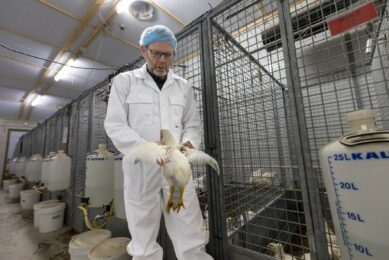Influence of two-hand catching methods in broilers
![Mechanical catching equipment is not suitable for all types of houses. [Photo: Roel Dijkstra]](https://www.poultryworld.net/app/uploads/2021/04/001_745_rb-image-2692611-848x565.jpeg)
In poultry production most steps are mechanised, whereas broiler catching is typically done by hand, since houses are not always suitable for the use of catching machines.
In Germany, hand catching with five to eight workers is still standard. Catching is considered to be one of the most stressful situations in the life of a broiler. For this reason, recommendations for the catching process of broilers were made by the Council of Europe in 1995 and in 2000 by the Scientific Committee of Animal Health and Animal Welfare of the EU. Based on the recommendations of the Council of Europe for domestic fowl (Gallus gallus), national guidelines in Germany were published in 2012 banning one-leg-carrying of birds.
Also read: Harvest broilers without catching
However, meaningful data for catching birds by two legs are lacking. Reported lesions observed during catching (not always indicating the catching method applied) range between 4.5% and 15%. Studies from 1980 and 1990 do not always mention the type of transport cages used. In recent decades, plastic cages with a small opening on the top of the cage have been used. Where possible, modular containers with cages resembling drawers with a wide opening are used.
Studies have also focused on the catching and transport of birds and their influence on stress parameters such as blood cortisol concentration. In this study, the effects of two catching methods on body, leg and wing lesions after the hand-catching of broilers by one or two legs for two weight classes (light animals: about 1.9 kg at pre-catching; heavy animals: about 2.5 kg at final depopulation) were compared.
Also read: Getting welfare right at catching time
Lesions on the body, legs and wings (haemorrhages and fractures) were recorded by a camera system located behind the plucking position. Two weight classes, two catching teams, and two flocks were included in the study. Heavy animals showed more lesions than birds of the light weight class. In all investigations, lesions on the body and legs were rare, whereas wing lesions occurred at a rate of up to 15.32%. Statistical analysis showed no significant difference between the two methods or between the catching teams for both weight classes. A correlation between lesions and weight was observed. During two-leg catching, the animals appeared to be more restless. Also, conditions for workers are considered harder.
Join 31,000+ subscribers
Subscribe to our newsletter to stay updated about all the need-to-know content in the poultry sector, three times a week. Beheer
Beheer








 WP Admin
WP Admin  Bewerk bericht
Bewerk bericht